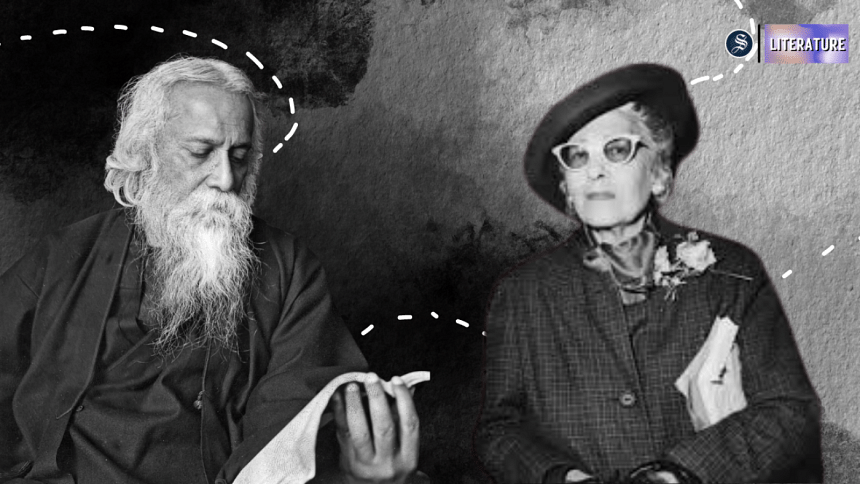Tagore and the Hispanic world

Today the Latin American readership in the Indian subcontinent plays a crucial role in building-up the Global-South unity. Here the growing enthusiasm for Latin American literature coincided with some major political events. During the Latin American "boom", Bangladesh was liberating itself from the claws of West Pakistan, swarming refugees were crossing borders, and socialism was spreading to certain parts of India. It won't be too difficult to understand that readers who directly went through socio-political repression and those who grew an empathy for their fellow countrymen found somewhat similar imagery in Latin American literature.
But this was not our maiden connection with the Hispanic world—rather, the first connection dates back to the early twentieth century, when Spain and Argentina embraced Rabindranath Tagore. This reception of Tagore in the Hispanic world is a significant literary event in itself because they acknowledged Tagore during such a time when the occidental enthusiasm for him was declining. Shyama Prasad Ganguly, an eminent Hispanic scholar, notes:
"Unlike in most parts of the west, where one observed a tapering off of Tagore enthusiasm within a comparatively short span of time after the award of the Nobel prize, whatever be the reasons—the inadequacy of translation, a fast change of taste or an unfavorable socio-political situation, the Hispanic response, particularly in Spain and Argentina, did not suffer such decline."
Shyama Prasad Ganguly, along with Shishir K Das, explored Tagore's reception in Spain in their scholarly work, Shashwata Mouchaak: Rabindranath o Spain (Eternal Honeycomb: Rabindranath and Spain). Their accounts of Tagore's growing popularity in Spain reveal a few facts to us. For instance, in 1985 a Spanish poet, Jose Lopez Martinez, dedicated a poem to Tagore where he expressed his desire of becoming a disciple of the poet. From Das and Ganguly's annals, we get to know of a Spanish poetry award named after Tagore—Premio de poesia Rabindranath Tagore. They argued by quoting a Rafael Alberti poem dedicated to Tagore, from his 1925 anthology Marinero en tierra, that Spain had long looked affectionately towards the Bay of Bengal.
Tagore was translated independently in Spain and Argentina by Juan Ramon Jimenez, Zenobia Camprubi, and V Gonzalez. It was mainly Juan Ramon and Zenobia Camprubi who were responsible for Tagore's popularity in Spain and in other Hispanic parts of the world. Before going into detail of Tagore's reception in Spain, it's worth noting that the first Spanish translations of his works were Hundred poems of Kabir and The Crescent Moon in 1915, and not Gitanjali.
Juan Ramon discovered Tagore in a difficult phase in his life, and during that same period he met Zenobia Camprubi, who kindled his interest in translating Tagore in Spanish. Now, it is well known to us that Juan Ramon, a weak reader in English, had Camprubi create the first draft of translations which he then edited. However, Jimenez was personally inspired by Tagore. His famous "Poesia desnuda" ("Naked poetry") was actually inspired from a Gitanjali poem, "My song has put off her adornments". The Spanish literary critic, Ceferino Santos Escudero, interestingly noticed an impact of Hindu mysticism in Juan Ramon's poetry, which made his poetry distinct from contemporaries such as Federico Garcia Lorca and Antonio Machado. However, any impact of Tagore on Jimenez was later discarded by another Spanish literary critic, Graciela Palau de Nemes.
When Tagore became aware of his readers in Spain, he expressed his amazement in a letter written as a response to Zenobia Camprubi, dated October 27, 1918. In the same letter, he said, "I believe there is something in the atmosphere and in the physical aspects of your motherland somewhat similar to those in ours which brings my lyrics close to your hearts. And this inspires in me a strong desire to visit your country." But sadly, he never made it to Spain.
The emphatic Spanish response to Tagore leaves us with a handful of unanswered questions: Why was it "Shishu" and the play Daakghar, instead of Gitanjali, that made Spain fall in love with Tagore? Why was a thinker of Jose Ortega y Gasset's stature so moved by Tagore's philosophy? These questions remain to be answered rationally by potential scholars in the future. For now, let us move to the South American context.
Tagore was first translated in Argentina by V Gonzalez. Gonzalez, unlike Jimenez, was also interested in exploring India critically through Tagore. He was arguably the first among the Latin American men of letters who understood the Indian medieval "Bhakti" from Tagore's words and verses. S.P. Ganguly says: "The translation was inspired by a personal commitment to studying and propagating the concept of love and brotherhood in the hatred-ridden climate of his country."
But Victoria Ocampo—Tagore's friend and "Vijaya" of "Purabi"—did not read Tagore in Spanish translations. It was Andre Gide's French translation that introduced her to the mystic world of Tagore. Recalling her first experience of reading Tagore appeared many times in her writing. For example, she writes in her book, Tagore en las barrancas de San Isidro: "I was leaning against a white marble fireplace in a room upholstered with light grey silk. The house no longer exists. Neither do the people who surrounded me in those days. Nor does the poet whose voice brought to me the gift of my own tears, which even an affectionate hug from the most intimate friend could not have done."
Ocampo read Tagore when she was suffering from a failed marriage and was involved in a clandestine relationship with one of her husband's cousins. Reading the poet must have alleviated her scars. Moved by his verses, she wrote an article for La Nacion, entitled, "The Joy of Reading Tagore", where she compared Tagore's works with Marcel Proust.
Tagore descended in Buenos Aires from the Andes on November 6, 1924. He was on his way to Peru to attend the hundred year celebration of The Battle of Ayacucho. Midway, he caught the influenza. In those days, there were no antibiotics available for the flu, so he had to stop in Argentina to recover his health. There, the rendezvous between Tagore and Ocampo took place. Ocampo rented a house for him, named Miralrio, beside the heavenly Rio de la Plata. Tagore along with his secretary, Leonard Elmhirst, moved into that house. It was there he wrote, "Lady, you have filled these exiled days of mine / with sweetness, made a foreign traveller your own" (Lines from the poem "Atithi").
At Miralrio, Tagore and Ocampo enjoyed each other's company. But Tagore feared beforehand that he would have to pay for Ocampo's absence once they had parted. In a poem, entitled "Shesh Basanta", he wrote: "In your blossoming flower-garden / I'll not linger needlessly / nor look back / when the day ends and it's time for leave-taking."
In the end, Tagore cancelled his plans of going to Peru and extended his stay in Argentina for a few more weeks, but soon took his leave and sailed off. He suffered Ocampo's absence and met her in Paris for the last time during his art exhibition a few years later, although the two continued their correspondence.
Tagore asked her to come and see his school in Shantiniketan, but Ocampo never made it to India. However after Tagore's demise, she contributed an essay, "Tagore on the banks of River Plate", to the centenary volume on Tagore brought out by Sahitya Akademi, and also brought out a special issue of "Sur", the journal she edited, on Tagore's birth centenary.
Ketaki Kushari Dyson, in her book, In Your Blossoming Flower Garden, gave a short account of Ocampo's upbringing, from which it is evident that in the course of her life, she became a well read woman and a progressive thinker. Treating her merely as Tagore's muse would be an injustice to her intellect. But here in Bengal, her identity has become inseparable from Tagore to some extent. She was the woman for whom the poet longed. Tagore wrote to Elmhirst on March 4, 1925: "I know love is precious in this world and yet helplessly to allow it to be wasted hurts me deeply. Now that I am away from Vijaya the pressure of her gift no longer oppresses my mind—I only feel the beauty of it, and the intense cry of her pain from our endless separation seems to burn like a star."
We don't have any evident record to trace Tagore's status in the Hispanic world today, but here, Ocampo still lives in our hearts. She continues to live as Tagore's "Bideshini" ("Beloved foreigner").
Soumalya Chatterjee, from India, is a former student of Comparative Literature at Jadavpur University.

 For all latest news, follow The Daily Star's Google News channel.
For all latest news, follow The Daily Star's Google News channel. 












Comments